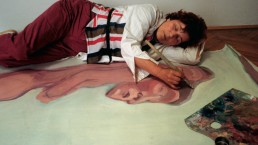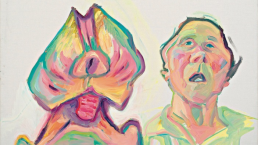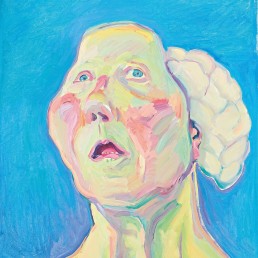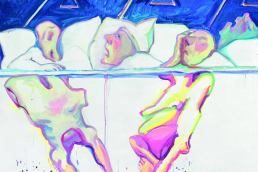
“I searched for a reality that was more fully in my possession than the exterior world, and I found it waiting for me in the body house in which I dwell, the realest and clearest reality.” – Maria Lassnig
Artland’s Lost (and Found) Artist Series focuses on artists who were originally omitted from the mainstream art canon or largely invisible for most of their career. Last edition we learned more about the specific style of abstraction that belonged to Alma Thomas. This week, we will explore an artist who is today regarded as one of the most important female artists of the 20th and 21st century. However, she only started receiving wide international attention and acclaim well into her 60s. The artist in question is Maria Lassnig.
Who was Maria Lassnig?
Maria Lassnig (1919-2014) was an Austrian painter who became known for her Körperbewusstseinsbilder ‘Body Awareness Paintings’. Using distorted or exaggerated features, she depicted internal feelings and sensations.
Today, Lassnig’s art is praised around the world and featured in major museum exhibitions. This year, the Stedelijk Museum in Amsterdam is putting on a retrospective of her work (Maria Lassnig – Ways of Being, through 11 August 2019). In 2016, there was a major show of her work at Tate Liverpool. 2014 saw the artist’s works in an impressive retrospective at MoMA PS1 in New York. However, it took her a long time to get to this point. Most people only seemed to start comprehending what she wanted to convey with her art later in her life, when she was in her 60s and had been working steadily for decades.
The artist, who died at the age of 94 in 2014, lived long enough to see the fruits of her labour and to experience her works in major gallery and museum collections and exhibitions.



“The moral issue of exaggeration: one step too far and it becomes bizarre; not something I aspire to. The moral issue of time: how much time do I give an artwork? Every drawing is a triumph over the restlessness of the world.” – Maria Lassnig
Maria Lassnig – Vienna and Paris
Maria Lassnig enrolled at the Academy of Fine Arts in Vienna in 1940, during the Nazi occupation. There, she was pushed to paint only in the Nazi-approved social-realist style. However, she rebelled by reaching back to the greats of Austrian expressionism like Egon Schiele and Oskar Kokoschka. Starting in 1950, Lassnig turned her focus to abstract art. She became a member of the ‘Hundsgruppe’ (‘Dog Pack’), an Austrian avant-garde group which took inspiration from abstract expressionism and action painting. Members included Arik Brauer, Ernst Fuchs and Arnulf Rainer, among others. Between 1960 and 1968, Lassnig lived and worked in Paris, where she became friends with André Breton, Benjamin Péret and other members of the Surrealist movement. Her contact with the Surrealists would influence her in years to come in the development of her signature ‘Body Awareness Paintings’. In these years in Paris, Lassnig initially focused on what she called Strichbilder – large paintings made up entirely from coloured lines. However, she soon turned towards figuration and never looked back.

Maria Lassnig – The New York Years
In 1968, Lassnig moved to New York, where she would remain until 1980. However, her ‘Body Awareness Paintings’, which she was developing more and more, went largely unrecognised there. In fact, many galleries returned her portfolio with negative criticism. They called her works strange, morbid and even sick. Yet this did not deter Lassnig and she continued honing her craft and exploring this style of hyper-personal painting. At the same time, she became interested in film and started creating and releasing animated films. She found film to be a vehicle through which she could tell stories of her body’s journeys through the world. One of her most famous films is Kantate, in which she performs an autobiography of herself set to an Austrian folk tune, while dressing up in various costumes ranging from the Statue of Liberty to a punk rocker. In 1974, she co-founded the feminist avant-garde collective ‘Women/Artist/Filmmakers, Inc.’ together with fellow female artists Carolee Schneemann, Martha Edelheit and Silvianna Goldsmith, to name a few. She also started becoming more of a name in Europe, and exhibited often in Vienna. In 1980, she was appointed as the first female professor to teach painting at the Academy for Applied Arts in Vienna, which led her to move back to Austria. Her work now started to gain more and more international recognition.

Body Awareness Painting
To create her ‘Body Awareness Paintings’, Lassnig used a method which was in many ways inspired by Surrealism. She painted only her mental perception of herself and her feelings. To be more precise, she would only paint those sensations experienced by her body that she could physically feel. The result is a body that often looks like it is missing something, that even seems deformed. It could be missing ears, or arms, or any other part of her body that she did not feel at the time of painting. Lassnig’s bodily sensations were what helped her define her relationship to the world. She was interested in capturing the full spectrum of bodily experience. All the flaws, all the sensations, all the different moods and aspects of the body. She wanted to paint things that were uncomfortable, embarrassing even. Often this results in awkward, twisting eyes and strange, bulging, lopsided body parts.
Du Oder Ich (‘You Or Me’) presents the artist naked, hairless and earless, wielding two guns. One gun is pointed at her head, the other at the viewer (perhaps referring to her long-denied recognition). In Dame Mit Hirn (‘Lady with Brain’), we see the artist’s neck and head, but her hair and her right ear are missing. A brain grows out of her left ear, on the side of her head. In Two Ways of Being (Double Self-Portrait), we see one Maria Lassnig fully clothed, face twisted into a kind of mute, confused cry. To her left is another Maria Lassnig, but this one is turned inside out. Blood, bones, muscles are fully exposed and set above her bare chest. It is not always necessarily a pleasant experience to look at a ‘Body Awareness Painting’, but while looking it becomes increasingly clear that it is a necessary one. It is almost a relief seeing how Lassnig put all her sensations, fears and shame onto her canvases to be observed up close by others. It suggests that there will be, and already is, more space for our flaws, our questions, and our deepest worries and fears.

The Star Continues to Rise
With her professorship in Vienna in the ‘80s came an increase in recognition for Lassnig’s work. In 1988, she was awarded the Austrian State Prize. By the ’90s, her influence on other artists could be clearly recognised. Artists like Thomas Schütte, Nicole Eisenman and Dana Schutz were deeply inspired by Lassnig. In 2013, she was the recipient of the Venice Biennale Golden Lion for Lifetime Achievement. In 2014, the year of her death, came the acclaimed MoMA PS1 show, which was the most significant survey of her work ever shown in the US. Lassnig has been represented by Hauser & Wirth and Friedrich Petzel Gallery for many years. Today, her works are in the collections of many major museum institutions including the MoMA, the Essl Collection of Contemporary Art, and the Museum Ludwig in Cologne. Countless young contemporary artists look to her work for inspiration and answers. As such, the legacy of Maria Lassnig lives on.
